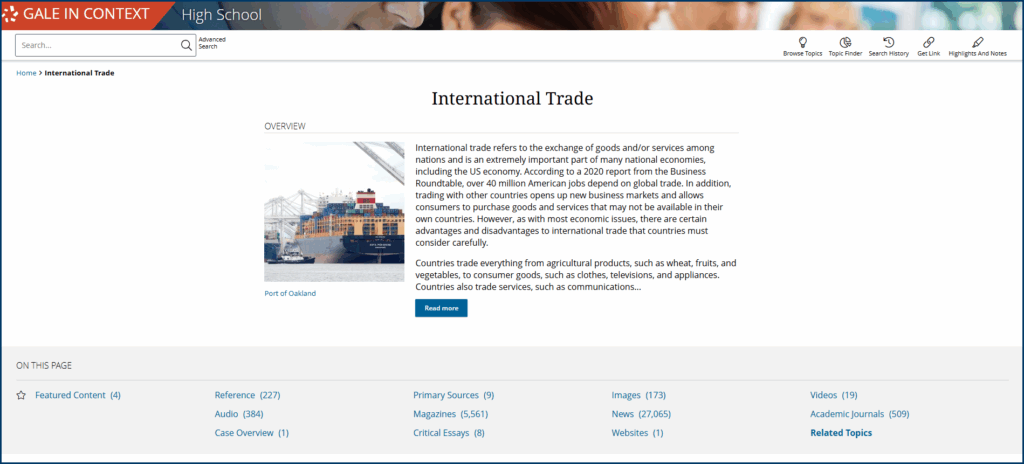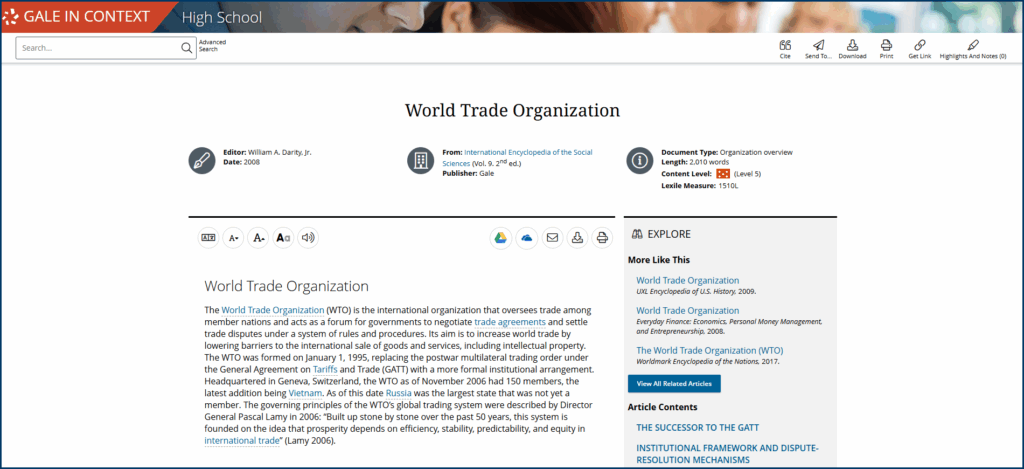| By Gale Staff |
In May, the United States and China agreed to ease tariffs for 90 days, while further negotiations take place on a long-term trade deal. The United States dropped duties on Chinese imports from 145% down to 30%, while China lowered its 125% tariffs on American goods to just 10%. Yet, even as one trade war seemed to cool, another appeared ready to ignite, with the US eyeing new tariffs on European pharmaceuticals amid simmering disputes over trade imbalances.
For most high school students, tariffs sound like an abstract concept. They might hear headlines in passing, but often lack the context to connect those stories to the price of a new phone or understand why certain products seem to vanish from shelves overnight.
With help from Gale In Context: High School, you can bridge the gap between policy and the real-world impact of tariffs. Invite your students to think critically about tariffs’ effect on our pocketbooks, paychecks, and the products we buy. Gale In Context: High School boasts thousands of articles on tariffs, including news stories, reference entries, interviews, videos, case studies, and a wealth of historical perspective.
After beginning with introductory discussion to understand what tariffs are and how they work, we will then consider some historical and geopolitical context. Finally, we’ll get into some of the rationale behind tariffs, and close with a look at how this very old economic tool is entering uncharted territory: namely, the entertainment industry.
Let’s dive in.
What Are Tariffs?
On a basic level, tariffs are taxes placed on imported goods. When a product crosses a border, a tariff increases the cost of bringing that product into the country. That price can vary depending on the product, the country of origin, or the political context. Though the importer pays the tax, that added cost trickles down to the consumer through higher prices at the store.
Tariffs are one of the oldest tools in international trade. Governments use them to shape economic relationships, influence consumer behavior, and sometimes gain a strategic edge in global trade by making their own industries more competitive.
Let’s consider a recent example. In 2024, the US proposed raising tariffs on certain Chinese-made footwear to as high as 60%. If a pair of imported shoes costs $100 wholesale plus $60 in duties, the importer pays $160 total to get that product into the US market. To maintain their margins, retailers pass much of that increase to the buyer, meaning that shoes that once sold for $150 could now retail for $210.
Such a price spike changes what consumers are willing to buy—but it can also force companies to reconsider what they can afford to sell. Even if demand remains high, the added cost from tariffs can make certain products unprofitable. In response, manufacturers might roll out redesigns with cheaper materials, push releases back to a later season, or source goods from different countries to avoid tariffs.
Because of the number of goods that no longer make financial sense, the ripple effect then further impacts jobs tied to shipping, marketing, and retail.
Tariffs as a Source of Revenue
Before income or sales taxes existed, tariffs were the backbone of many national budgets. In the late 18th and much of the 19th century, the United States relied heavily on duties collected at ports to fund federal spending. Some estimates show that tariffs accounted for more than 90% of US government revenue from 1790 to 1860.
Today, wealthy and politically stable nations typically use more complex income and corporate tax systems to raise revenue. But in some parts of the world today—particularly in less industrialized nations—it can be more difficult or politically risky to raise funds through domestic taxation. Tariffs, by design, are relatively easy for governments to administer. They’re collected at borders as goods enter a country, which makes them less dependent on internal tax enforcement systems.
However, relying on tariffs can create uneven effects. Because the added cost applies to everyone, regardless of income, lower- and middle-income households often feel the impact more acutely. A tariff on imported staples may generate revenue for the state, but that makes it regressive, placing a heavier burden on those who live paycheck-to-paycheck and spend more of their income on necessities.
Critical Thinking Questions:
- In what ways do tariffs both reflect and reinforce global disparities in tax systems, and how might those differences affect a country’s ability to fund essential services or respond to emergencies like natural disasters or a public health crisis?
- If a tariff helps fund infrastructure but also raises food prices, how should policymakers weigh those costs and benefits?
Tariffs to Protect Domestic Industries
One of the most common justifications for tariffs is protectionism, an economic strategy intended to shield domestic industries from foreign competition and level the playing field for locally-made goods.
One high-profile example came in 2018, when imported aluminum and steel went under a 25% tariff, measures intended to revive American manufacturing and reduce dependence on foreign supply—particularly from China. In the short term, the move worked. US steel producers increased output over the previous year by 6%, adding 4,800 steel mill jobs to the economy by March 2019.
However, tariffs can undercut the economy they’re meant to support when the policy raises the cost of key materials like steel or aluminum.
In the case of the 2018 steel tariffs, US steel producers benefited, but soaring input costs squeezed automakers and construction firms. This resulted in mass layoffs across more than 80 industries that rely on steel input and higher prices for the everyday consumer.
Meanwhile, some American manufacturers—like Harley-Davidson—relocated parts of their production abroad to escape retaliatory tariffs that made exports unaffordable.
Critical Thinking Questions:
- Is it fair to make imported goods more expensive to protect local industries? Why or why not?
- Compare a protectionist policy aimed at preserving a legacy industry—like steel or textiles—with one focused on advancing a future-oriented sector, such as green energy or tech manufacturing. What might these choices reveal about the political and cultural priorities setting a country’s agenda?
Tariffs to Retaliate in Trade Disputes
Some tariffs are imposed proactively to protect domestic industries or shape consumer behavior. Retaliatory tariffs, however, are meant to serve as a consequence when one country believes another has violated the terms of a trade agreement.
Under most reciprocal trade arrangements—like those governed by the World Trade Organization (WTO)—countries agree to jointly lower or eliminate tariffs. These agreements are based on the understanding that neither side will gain an unfair advantage by supporting domestic companies with government subsidies, limiting foreign competitors’ access to local markets, or manipulating prices or currency in ways that distort trade. If one country violates those terms, retaliatory tariffs raise business costs, forcing the other side back to the negotiating table.
One example includes the long-running dispute over aircraft subsidies that began in 2004, in which the US accused the EU of giving unfair financial support to Airbus, a major European plane manufacturer.
After the WTO ruled in favor of the US, the US imposed tariffs on a wide range of EU exports, many of which were products not directly tied to the aviation industry. These back-and-forth measures had little to do with the companies involved in aircraft manufacturing, but the pressure was meant to build political urgency on both sides.
One of the most significant risks with retaliatory tariffs is how quickly they spill over into industries that had nothing to do with the original dispute. A family-owned vineyard in Spain and a farm cooperative in Iowa could lose half their buyers overnight after getting drawn into a broader policy standoff.
Critical Thinking Questions:
- When countries retaliate with tariffs, what outcomes are they hoping to achieve, and who will be most affected if those outcomes don’t materialize?
- What are the risks of using tariffs as a tool in a larger political strategy?
Digital Content and the Challenge of Tariff Attribution
Traditionally, tariffs only apply to physical goods. However, in a social media post on May 4, 2025, Donald Trump stated, “I am authorizing the Department of Commerce, and the United States Trade Representative, to immediately begin the process of instituting a 100% Tariff on any and all Movies coming into our Country that are produced in Foreign Lands.”
This post ignited debate over how—and where—governments should tax digital entertainment. In an industry defined by multinational collaborations, working through the specifics of tariffs is a complex issue.
Consider, for example, the production of HBO’s The Last of Us. Its lead actor, Bella Ramsey, is a British citizen hired by an American company to work on Canadian soil. From a policy standpoint, there’s no single country of origin. So how should the tariffs be applied? Based on where the show is filmed? The national origin of the cast and crew? And what if the storyline itself is based on an American-developed game—does that tilt the balance back toward the US?
Another consideration is that it’s not just the production companies who have economic stakes in this process. Countries like Canada and New Zealand and US states like New York and Georgia offer generous tax breaks to attract high-profile productions. In doing so, they provide valuable infrastructure, local expertise, and economic support. That being said, they also absorb costs, such as public wear and tear or resource strain, that don’t always yield a direct return. If tariffs are levied solely to benefit media platforms or distributors, these host nations may see little compensation despite being essential to the production pipeline.
Discussion Questions:
- How might tariffs on the entertainment industry differ in their economic and political effects from traditional tariffs on physical products?
- If governments begin to impose tariffs on foreign media, how might that shape the cultural narratives audiences are exposed to—and whose stories get told?
Tariffs are often explained in economic terms—trade balances, industry protection, government revenue—but their effects shape everyday consumer experience. They influence what products people can afford, which goods remain on shelves, and, potentially, even what media audiences can access.
Gale In Context: High School helps students better understand how trade policy intersects with questions big and small, remote and immediate: from economic forecasts and job reports, to the money coming out of their pockets. To give your learners access to these up-to-date resources and research tools, reach out to your local Gale sales representative to request a trial.



